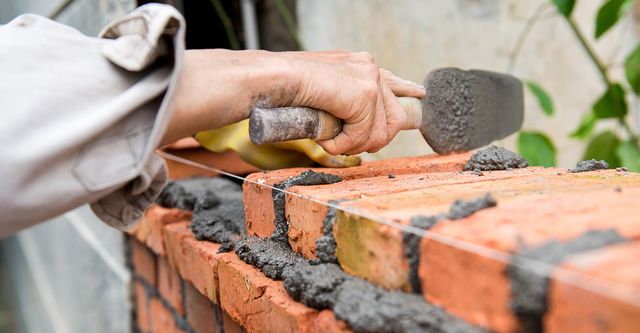Opening the Tricks of Sustainable Stonework Building Practices for Eco-Friendly Structures
In the world of contemporary building, the pursuit of lasting techniques has become extremely important. Amongst the myriad techniques to environmentally friendly building, lasting masonry building stands out as a time-tested and durable method that holds a wide range of untapped possibility. From the option of materials to ingenious building and construction techniques, the tricks to achieving sustainability within masonry building are diverse and appealing. By checking out the benefits, materials, techniques, and future trends of lasting stonework, a much deeper understanding of just how these techniques can form the future of eco-friendly structures arises.
Advantages of Lasting Stonework Building
Accepting sustainable masonry building and construction techniques not just minimizes environmental impact but additionally supplies long-lasting economic benefits to builders and areas. By making use of materials like recycled blocks, blocks, and stones, builders can considerably decrease the carbon impact of their tasks while advertising source performance. In addition, lasting masonry construction techniques, such as appropriate insulation and thermal mass buildings, can improve power efficiency within structures, resulting in lowered operational prices gradually.
Moreover, the resilience and strength of masonry structures contribute to lasting economic advantages. Buildings built utilizing lasting stonework techniques often need less repair and maintenance, converting to cost financial savings for home builders and residential property proprietors. The longevity of masonry products likewise ensures that frameworks stay secure and protected, decreasing the demand for regular renovations or substitutes.
Eco-Friendly Stonework Materials
Utilizing environment-friendly masonry materials is a pivotal action in the direction of improving the sustainability of building practices and minimizing ecological influence while maximizing lasting financial benefits. Sustainable stonework products are sourced, produced, and made use of in a way that minimizes overall ecological effect. Sustainable concrete blocks include recycled aggregates and may include improved insulation residential or commercial properties, adding to energy efficiency in buildings.
Furthermore, all-natural materials like adobe, rammed planet, and straw bales provide exceptional thermal mass homes, reducing the requirement for home heating and cooling power. These materials are commonly locally readily available, promoting local economies and reducing transportation-related carbon exhausts. By selecting green masonry products, construction jobs can significantly decrease their ecological footprint and contribute to the development of much healthier, a lot more sustainable constructed environments.
Energy-Efficient Stonework Techniques
Power performance plays an essential role in improving the sustainability of masonry building methods. One crucial energy-efficient stonework method is the usage of thermal mass, which includes integrating dense materials like concrete or brick into the structure's framework to soak up and save warmth.

Developments in Sustainable Stonework
Recent developments in sustainable masonry practices have caused ingenious techniques that are improving the construction sector. One such advancement is the advancement of self-healing concrete, which utilizes microorganisms installed within the concrete to recover splits autonomously. This innovation not just reduces upkeep expenses however additionally improves the sturdiness of masonry structures, adding to their sustainability.
One more notable technology is using recycled aggregates in masonry building and construction - masonry contractor. By including products such as crushed ceramic waste or recycled glass right into concrete blends, home builders can lower the environmental impact of building tasks while keeping structural integrity. This method not just draws away waste from land fills yet also saves all-natural sources, making it a crucial advancement in lasting stonework construction
In addition, the integration of digital layout tools, such as Structure Information Modeling (BIM), is reinventing the method masonry structures are planned and constructed. BIM permits for more specific calculations, lowered product wastage, and improved power performance, ultimately causing more sustainable structure practices. These advancements jointly signify a promising future for lasting stonework building and construction in the age of eco-friendly buildings.
Future Trends in Stonework Sustainability
With the ingenious strides made in lasting stonework methods, the future fads in masonry sustainability are positioned to more revolutionize the building industry. Among the key fads shaping the future of stonework sustainability is the boosted integration of innovation. Advancements such as Structure Info Modeling (BIM) and online reality simulations are being made use of to enhance masonry building and construction procedures, resulting in reduced product waste and enhanced power effectiveness in buildings.
In addition, the growth of novel lasting products is established to play a considerable role in boosting the eco-friendliness of masonry building and construction. masonry contractor. Advancements like self-healing concrete, recycled aggregates, and bio-based binders are obtaining grip for their ability to decrease environmental impact while keeping architectural integrity

Conclusion
To conclude, sustainable stonework building practices use numerous benefits for green buildings. By making use of eco-friendly products and energy-efficient strategies, stonework can add to an extra lasting constructed setting. Technologies in lasting stonework are continually being created to additionally improve the ecological efficiency of buildings. Looking towards the future, the pattern of masonry sustainability is expected to grow, causing even more environmentally friendly and energy-efficient building techniques in the years to come.